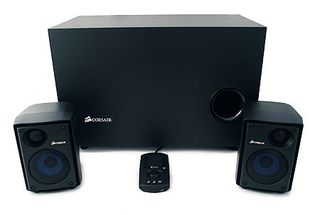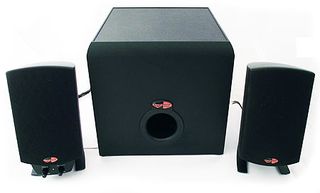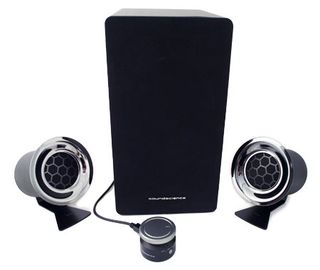Bringing Home The Bass: 2.1-Channel Speaker Roundup
Is it just us, or are 5.1- and 7.1-channel speaker systems impractical for PCs? In our 2.1 speaker roundup, we look at the Corsair SP2500 and Antec/Soundscience Rockus 3D|2.1, along with the Creative Gigaworks 3D, Klipsch Promedia 2.1, and Logitech Z623.
Subjective Testing And Conclusion
Even the cheapest LCD television will look great when it’s all by itself. But when you put it beside the premium model and play the same content, that’s when you’ll see a difference. It’s the same thing with speaker systems. I prefer quantitative testing over general opinions any day of the week, but subjective benchmarking can expose weaknesses and strengths of audio and video equipment, as long as you have a number of products to compare.
I played a number of songs and games on all five of these speaker systems. Comparing songs is easy, as I simply listened and quickly swapped the auxiliary jack between them to note the difference. Games are a little harder to test side by side, so I recorded some Call Of Duty gameplay to a .wav file and compared the speakers as I did with music.
Here are the records of my observations, and since my conclusions are closely intertwined, it’s difficult to separate the two.

Corsair SP2500
The Corsair SP2500 sounds good to my ear, whether playing back hard-hitting games or all sorts of music. I did notice a kind of hollowness in the mid-range—with vocals particularly—and this does reflect the valley we saw in the frequency response at 3.5 kHz. The good news is that the EQ settings can be used to mitigate this issue, and I found I could tweak the sound to taste. The bass is great, as deep or shallow as you ask it to be, but still clear and undistorted.
The tweakability, options, and even the bling offered by the color LCD-equipped remote, are the SP2500’s strong points, and do set this system apart from the rest of the playing field. I’m not sure I’d pay the extra $100 over the Logitech Z623 and Klipsch Promedia 2.1, but if I did decide to shell out the cash, I think I could justify it. If you’re interested in the SP2500s, just make sure you have enough available floor space to accommodate the 18” wide subwoofer enclosure.

Creative Gigaworks T3
Creative’s Gigaworks T3 system is surprisingly hard-hitting when you consider the small satellites and footprint of the subwoofer. There’s big sound to be had from this system, with nice highs and good bass for a great game or music experience. The triple 6.5” driver-equipped subwoofer probably has a lot to do with that.
The remote works well, and the only functional complaint we have is that the bass level control is inconveniently located on the back of the subwoofer enclosure. Aside from this, the $249 price tag is probably our biggest stumbling block when it comes to the T3. Unless small size and a remote are your paramount requirements, the Creative Gigaworks T3 is a difficult sell compared to some lower-priced options.

Klipsch Promedia 2.1
Even after 10 years, the Klipsch Promedia 2.1 remains a rock-solid PC speaker system capable of great things, including a nice flat frequency response and powerful bass. It certainly seems worthy of the THX certification. The worst thing we can say about this system is that the highest 10 kHz+ end of the audio spectrum might be a little weak. But it’s not so bad that it’s easy to notice, even when you’re directly comparing it to its contemporaries.
At $154.99, you really can’t go wrong with the Klipsch Promedia 2.1 unless you can’t stand controls on a satellite and absolutely must have a remote. If you’re seriously thinking about picking up this system, you should also consider the Logitech Z623.

Logitech Z623
Logitech’s Z-2300 has been the product to beat for years, and the new Z623 has taken its place as Logitech’s premier 2.1-channel offering with THX certification. Without a Z-2300 on hand, I can’t compare these systems to each other, but compared to the rest of the current playing field, the Logitech Z623 certainly holds its own. It boasts a flat frequency response with gobs of bass available for games and music at your command. There’s even a bit of brilliance on the high end.
At $146.99, I can’t think of anything bad to say about the Logitech Z623 except that the Klipsch Promedia 2.1 is priced similarly. Picking a clear winner between these two is almost impossible, as it comes down to personal taste. If you’re interested in either one, I heartily suggest you take both of them for a spin at your local electronics outlet.

Soundscience Rockus 3D
Antec bursts on to the audio scene with the new Soundscience brand and its first product, the Rockus 3D|2.1. It’s hard not to be impressed with the Rockus, with its beautiful anodized aluminum satellites and tall subwoofer.
How does it sound? Clear and rich, but compared to the competition, the bass presence is lacking. There are details that I had trouble making out in the bass range and muted sounds I knew should be there in songs I am familiar with. I’ll be the first person to admit that bass presence is often over-accentuated in some subwoofer-equipped audio systems, and it’s quite possible that I’ve become so accustomed to too much bass that I can’t appreciate a flat frequency response anymore.
Having said that, all of the other systems we’ve tested in this roundup allow for bass adjustment from very low to very high, but the Rockus 3D|2.1 restricts bass adjustment from medium-low to medium. Soundscience might be taking a stand against artificially overloaded bass, but in a premium product like this, why not simply provide more flexibility so the user can set it to taste? Aside from this, I am also disappointed in the lack of headphone output on the remote. For a premium PC speaker system, I consider this a must.
Admittedly, 3D mode kicks up the bass level and even adds a tangible surround effect, but at the expense of some mids and highs. And let’s not forget that the Rockus 3D|2.1 is on a very short list of 2.1 speaker systems with a digital optical input. If the Rockus' aesthetics and these unique features appeal to your taste, and you don't feel the need for an overly pronounced bass presence, then Soundscience’s flagship product will make it to your short list. Antec has shown us some potential with its Soundscience brand and we look forward to what the company can come up with in the future. But for $249.99, there are some compromises to be made here that lower-priced options do not demand.
A Final Note
To all PC speaker manufacturers out there taking aim at the gamer market: I’d like you to know that we really do appreciate the conveniently-located headphone jacks you include on remotes and satellites.
Unfortunately, gamers don't just listen, they talk. Nobody has figured out that gamers need a microphone pass-through jack for our headsets, too. Please—somebody, anybody—make this a standard feature on PC speaker systems!
Current page: Subjective Testing And Conclusion
Prev Page Objective Benchmarks: Bass Range ControlStay on the Cutting Edge
Join the experts who read Tom's Hardware for the inside track on enthusiast PC tech news — and have for over 25 years. We'll send breaking news and in-depth reviews of CPUs, GPUs, AI, maker hardware and more straight to your inbox.
-
clownbaby Wow, those freq response graphs are pretty telling that computer speakers are basically all trash. The bass peaks and generally crappiness in the mid range seem to be a common theme. Almost no consideration seems to be given to music listening.Reply
2.1 is the ideal setup for a computer imo. 4.1 at most. A center channel just isn't needed for monitor sized screens.
You can buy a cheap onkyo receiver, some low end bookshelf speakers and a small sub for a few hundred bucks and have sound that will destroy the best pc speakers.
The fact is, pc speakers are toys. There is no high end option. What they market as high end would be laughed out the door by the regular audio comminuty.
p.s. Plastic is not an acceptable cabinet material -
clownbaby this is what frequency response graphs of decent speakers should look like.Reply
http://www.speakerdesignworks.com/StatementCenterChannelResponsePlots.JPG -
clownbaby this is a frequency response graph of the first diy speaker I built from a popular design. This is a super budget MTM speaker.Reply
http://www.speakerdesignworks.com/TritrixMTMfr.gif -
d0gr0ck clownbabyWow, those freq response graphs are pretty telling that computer speakers are basically all trash. The bass peaks and generally crappiness in the mid range seem to be a common theme. Almost no consideration seems to be given to music listening.2.1 is the ideal setup for a computer imo. 4.1 at most. A center channel just isn't needed for monitor sized screens.You can buy a cheap onkyo receiver, some low end bookshelf speakers and a small sub for a few hundred bucks and have sound that will destroy the best pc speakers. The fact is, pc speakers are toys. There is no high end option. What they market as high end would be laughed out the door by the regular audio comminuty.p.s. Plastic is not an acceptable cabinet materialReply
Pretty much this. I've been telling people for ages that their super-duper PC speakers aren't. Any brand that quotes max power over RMS values raises an instant red flag for me. Even 20yr old Radioshack shelf speakers can run circles on most modern PC speakers.
I die a little bit every time I hear someone with a premium add-in sound card is running generic PC speakers.
-
tigsounds This is all Go out and buy it junk. Build your own and end up with something that rattles the neighbors nerves if done right.Reply -
Mark Heath For all those who trash all PC speakers, they're usually the best option on the lower end of the scale. There are people out there who have compared entry level (sub 400) active speakers to the Klipsch Promedia set (best active speakers ~150 for sound quality imo) and they say that they're not that different. If you do it right, then it's not as bad as you might think.Reply
